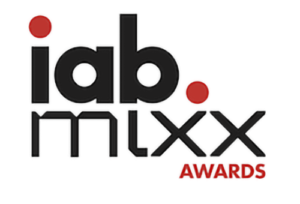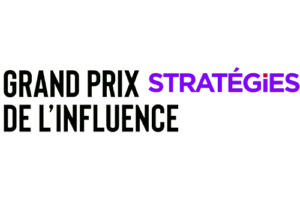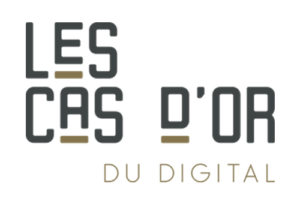Photos, videos, carousels, but also reels, stories or even lives… When you publish content on Instagram, you’re spoilt for choice when it comes to format – and location. But in the midst of all these different types of posts, you may find yourself wavering in your content strategy: would a video be more effective than a photo? Should it be a post or a story? And why not a live broadcast?
With the plethora of different formats and locations on Instagram, we’ve prepared this Stellar guide dedicated to the different types of posts on Instagram, their advantages and disadvantages. The answers to all your questions are in the following lines!
Want to discover all 2024 influencer marketing trends?
Find out all there is to know about social media trends, strategies and features this year.
Among the types of formats that your posts can adopt on Instagram, there are three main categories: photos, carousels and videos. Over the years, Instagram and its algorithm have largely evolved these different types of content and their respective performances on the network. So, what can we say about these formats today?

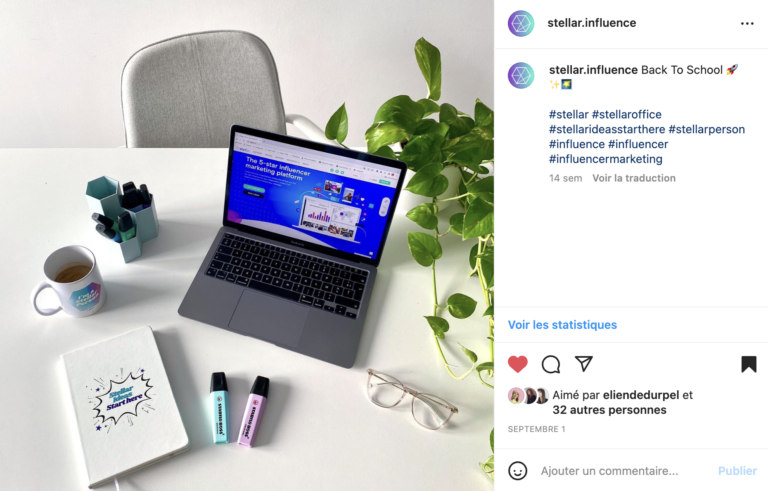
The photo is indeed the basic format on Instagram. When it was created in 2010, the idea was above all to show people’s daily life in its most beautiful light: pretty shots of one’s breakfast, family walks, or incredible landscapes. By emphasizing the immediacy of shared moments (hence its name), the Instagram platform also developed stories, an ephemeral and spontaneous format.
Today, Instagram photos are much more than that: they serve as a branding tool, both personal and professional. Brands share photos of their products, artists post their photos, drawings or graphic illustrations, and influencers show and define their brand image through photos of their daily lives.
Instagram photo sizes vary between 3 formats:
Advantages | Disadvantages |
Effective personal and professional branding tool. | Has less organic reach than other Instagram formats (reels) |
The easiest and fastest format to create | Less and less effective format to stand out and attract followers’ attention |
Instagram stories go from 15 to 60 seconds
Since September 2022, it is now possible to post long stories of 60 seconds on the Instagram platform. The interruptions of videos are now gone, cut into segments of 15 seconds each: this longer story format, initiated in some countries since the end of 2021, is now developing worldwide. The opportunity to offer instant and ephemeral content, but of longer duration, to its subscribers.
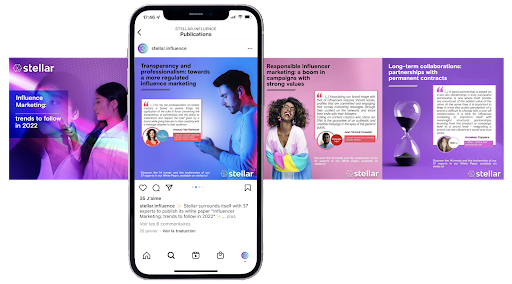
If dating apps have taught us one thing, it’s that users love to swipe. And when your followers swipe through your carousel on Instagram, they spend more time there: the platform’s algorithm then understands that it’s qualitative content and will tend to value it over other formats. This is also probably why the carousel is the type of post that generates the most engagement on Instagram right now.
The carousel can feature a mix of photos and/or videos. So it can be useful for many aspects of your Instagram strategy: showcasing an entire product line, expressing your creativity with aesthetically pleasing and consistent content, or storytelling with photo dumping.
The image formats for Instagram carousels are the same as for photos or videos. So you have the choice between 3 image sizes:
When it comes to Instagram carousel videos, there are a few format specifications to consider as well:
Advantages | Disadvantages |
Offers a wide range of content creation possibilities | Requires more time and preparation than a single photo |
Format that generates the most engagement on Instagram | |
Organic format valued by Instagram’s algorithm |
Two seconds: that’s the average time you have to catch users’ attention on social networks. So to retain them when you post, you need what’s called a “scroll-stopper“; in other words, a post that’s impactful enough to make users stop scrolling.
Today, video is the best way to keep users’ attention on Instagram. Not to mention that video on Instagram can take many different forms: reels, stories or lives, each type of video can be very useful in your content strategy. Whether it’s to increase your brand awareness, engage with your community or grow it, right now, video is king on social media.
Note that now, if you want to post a video on your Instagram news feed, it will automatically be shared as a reel. This means that it will still appear on your feed, but it will also be able to reach a wider audience by appearing as a suggestion to other users.
The format of Instagram videos must respect a certain ratio in terms of proportions if you want them to remain as they are when you publish them. Otherwise, the platform will resize your videos, and you might be faced with a zoomed-in video or one surrounded by black bands. The ratio to respect is the following:
When it comes to the length of Instagram videos, this will depend on the type of content you post. So you will find different maximum lengths allowed for your videos:
Just like other content types, there are also some additional specifications required for videos:
Advantages | Disadvantages |
Offers a wide range of content creation and storytelling possibilities | Requires time and a certain mastery of tools and codes |
Format that best captures users’ attention | The video must attract attention from the first few seconds to work well |
Format that generates the most organic reach on Instagram |
How to post a GIF on Instagram?
You like memes and you want to publish a GIF in post or story on Instagram? It’s possible! Since the acquisition of Giphy by Facebook in 2020, you can post GIFs on Meta social networks.
To do so, you’ll need to download the Giphy app on your mobile device and select the “share” option for the image of your choice. If you want to post a GIF you’ve created, you’ll need to upload it to Giphy first. Be careful it must be longer than 3 seconds, the minimum length for videos on Instagram.
After this overview of the types of formats (photo, carousel or video) that it is possible to use on Instagram, it seems relevant to look at the different types of content you can publish on the platform. Just like formats, content types are diverse and varied, and also have a range of advantages and disadvantages when it comes to establishing an effective and relevant content strategy.
On Instagram, there are 6 different major content categories: news feed posts, reels, stories, lives, guides, and Instagram shopping.
Posts on your news feed, wall, or feed, are the essence of your Instagram account. These posts are found on your profile as a grid, in thumbnail size, and appear on the news feeds of your followers. Harmony is therefore usually the order of the day: when users arrive on a profile, they feel the look & feel of the brand, the influencer or the person who owns the account. The publications on the wall are therefore essential to develop your content strategy, in order to build the image and the universe of your brand.
The objective of the Instagram wall: to encourage users to follow the brand, the company or the influencer by subscribing to his account. At a glance, the DNA elements of the brand or personality must be able to stand out from the feed: tone, credibility, expertise, aesthetics, interests…
But in-feed posts can also appear in other places on Instagram: in the “explore” section, for example, or when users search for one of the hashtags you’ve associated with your post. To increase your visibility and organic reach, it is therefore important to develop an effective hashtags strategy, coupled with a tags strategy (location, people, pages…).
Advantages | Disadvantages |
Allows to create and consolidate a harmonious and coherent brand image. | Requires additional work on content strategy to keep the feed aesthetically pleasing, engaging and consistent over the long term |
It highlights your brand and allows you to improve your image | Requires an effective hashtags and tags strategy to work well organically |
Introduced in 2020 to compete with the TikTok platform, the reels feature allows you to create short videos, to which you can add filters, effects, music, and other creative tools. It is possible to include reels in the classic news feed, where photos and carousels are displayed, but these videos will also be displayed on your profile in a dedicated tab.
One advantage of this format is that it allows your videos to appear when users are browsing other reels; like TikTok, they automatically scroll below each other. Since recently, reels are also favored by the Instagram algorithm in the “explore” or search section. They therefore allow to reach a wider audience organically.
Note that since July 2022, it is possible to boost reels – previously, they could only be broadcast organically. Be careful though: only reels shorter than 60 seconds and in 9:16 format (1080 x 1920 pixels) can be sponsored on Instagram. If you’re thinking of posting an organic reel, it can be up to 10 minutes long.
Advantages | Disadvantages |
Reach a larger audience organically | Requires time and a certain mastery of tools and codes |
Increases engagement with the community | The real thing must attract attention from the first few seconds to work well |
Allows a lot of creative freedom |
The story is the most ephemeral and instantaneous Instagram publication, as it will only remain accessible for 24 hours organically. Stories appear at the top of users’ news feed, with the most recent ones first: it is therefore a format that requires a more regular publication than the others, ideally once a day, to reach its audience.
A big advantage of the story is that it does not need to be as elaborate as other Instagram formats. It can contain photos or videos, but also stickers, GIFs, links, or even interactive elements such as questions or polls that your followers can answer.
If you want to reach a wider audience, it is possible to set up a paid strategy by boosting a publication or with ads. Coupling this sponsorship with a hashtags and tags strategy will allow these stories to be shared organically.
Also note that if you want your story to last, you can add it to your highlights: the ideal is to create a few categories of highlights, each with a particular theme (about, products, news, behind-the-scenes…).
Advantages | Disadvantages |
Allows great visibility | Requires regular, even daily publication to keep in touch with users |
Very dynamic format, simple to create, which values authenticity and immediacy | |
Increases engagement with the community with interactive and fun elements (polls, questions, gifs, music,…) | |
Arouses users’ curiosity through its ephemeral and immersive nature | |
Allows users to re-share posts or stories from other accounts and encourage reciprocity |
Live, or live posting (also called “inline” on Instagram help pages), is a type of story on the platform. As the name suggests, it allows you to share live content with your users; you can also use filters or effects during your live. Connected users can then interact with you, by liking or commenting on your post.
The live stream appears, like stories, at the top of your followers’ news feed. The only difference is that it stays at the top of the feed throughout your live stream, with the “live” mention as a bonus and as a notification to your followers. Once the live video is finished, you can extend its broadcast as a classic story for 24 hours, or re-share it as a reel. It is also possible to upload your video to republish excerpts, for example, but you should know that comments and likes will not appear.
Advantages | Disadvantages |
Allows you to create a very high level of engagement with the community by interacting live | May be subject to unforeseen events and lower image quality |
Allows you to go live with other users in a Live Room | Cannot be boosted |
Positioned at the top of the stories throughout the broadcast |
Introduced in 2020, Instagram’s “guide” feature allows you to gather different publications, yours or other users’, into a single post. Unlike other formats, the guide doesn’t appear in the grid of your feed; it’s under a different tab on your profile. To encourage your followers to check it out, you can always share it in a story.
There are three types of Instagram guides:
Note that if you want to publish an Instagram guide, you’ll need to go to your profile and click the “+” in the top right corner, as this feature is not available from the homepage.
Advantages | Disadvantages |
Quick and easy to create, as you only need to collect already created publications | Does not appear in the news feed |
Allows you to collect and share consistent and quality content | May seem redundant to users who have already seen the publications collected in the guide |
Feature not yet widely used, which could help you stand out |
The Instagram shop is a part of the platform dedicated to selling products. In order to appear in the shop section, you will first need to set up your Instagram Shopping and create a Facebook catalog. Then, you can add your products to your store by tagging them on your posts. All types of posts can be added: feed, stories, reels, and even lives.
When you tag a post with a shopping tag, users who click on it are redirected to your product’s page. There, they will find a description, an image, the price, and a link to your website to buy the product. For stories tagged with shopping, users are invited to swipe up to view the product sheet.
Advantages | Disadvantages |
Easy to use once the configuration is done | Highly competitive publications |
Allows you to redirect users to your sales page directly | Difficulty to reach new users organically |
Requires some time to set up |
As we’ve seen in this article, Instagram is full of opportunities to publish creative, engaging and authentic content on its platform. But then, what type of post to publish for an effective marketing strategy?
In reality, there is no single answer to this question. The type of post you choose will depend on your objectives and your community. The important thing is to publish regularly enough, vary your content, test and track the performance of your posts. The best judge is your community, and how they interact with your content.
That said, it is possible to draw some broad lines on the type of post to publish according to your objectives:
If you’re looking to set up an influencer campaign on Instagram, be sure to check out our comprehensive guide to the KPIs you should use to learn how to set up and track your goals effectively.
